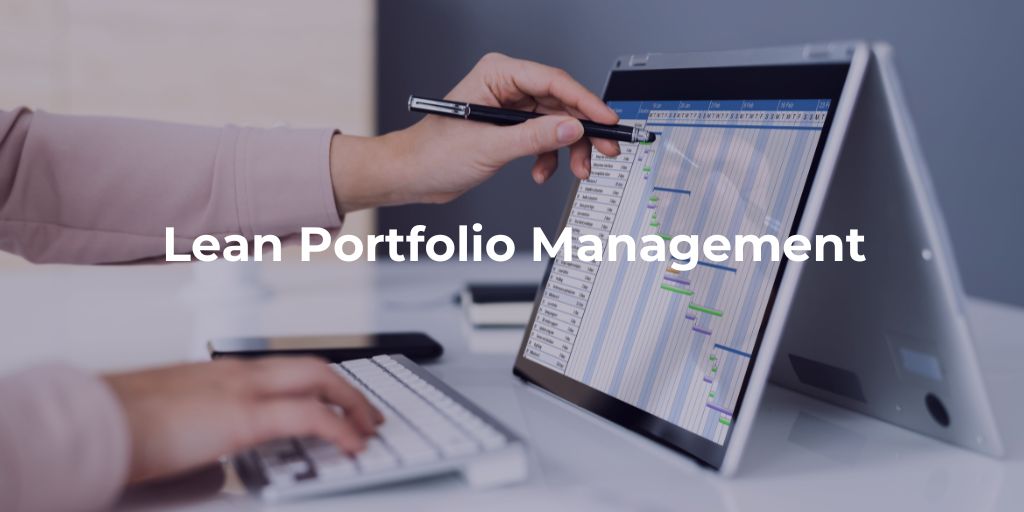Scaled Agile Framework (SAFe) provides a comprehensive approach to implementing Agile principles and practices at scale. SAFe is based on seven core competencies: in this article, we will explore Lean Portfolio Management.
Lean Portfolio Management (LPM) is one of the seven core competencies needed to achieve Business Agility. Each of the seven competences is supported by a self-assessment mechanism to evaluate the proficiency of the business.
Why should I use Lean Portfolio Management?
Traditional approaches to Portfolio Management are not suited to the needs of the digital age, where speed and innovation are key. Adapting Portfolio Management is key to introducing Lean-Agile methodologies and being successful in today’s business landscape.
The Lean Portfolio Manager assumes significant responsibility, overseeing decision-making and financial decisions, with roles distributed across organisational hierarchies. Managers and business owners lead Lean Portfolio Management activities, ensuring alignment between strategy and execution.
Within Lean Portfolio Management, three key dimensions can be identified:
- Investment Strategy and Financing
- Agile Portfolio Operation
- Lean Governance
These three dimensions are critical to an effective LPM implementation, as they facilitate alignment, execution support and governance oversight.
Investment Strategy and Financing
The investment strategy and financing in Portfolio Management ensure that the Portfolio is aligned with corporate objectives, facilitating a coherent allocation of resources. This collaboration involves executives, business owners and enterprise architects, linking the portfolio strategy to the overall vision.
Constant communication of the portfolio vision and strategy is essential to foster alignment and promote agility.
The Portfolio strategy must support the corporate objectives: linking the two is the main responsibility of the collaboration between strategy and investment financing.
The best way to predict the future state of a Portfolio is to create it through a Portfolio roadmap, that provides a flexible but focused vision for future initiatives, integrating lower-level initiatives and influencing solution development. Once the roadmaps are established and implemented, it is time to establish the budget and the lean roadmap.
Agile Portfolio Operations
Agile Portfolio management activities facilitate decentralised execution of Agile Release Trains (ARTs) and promote operational efficiency. SAFe principles and the Lean-Agile mindset enhance ARTs and Solution Trains by decentralising strategy execution.
Collaboration in Agile Portfolio management activities requires the active involvement of key figures, such as the Value Management Office (VMO), the Lean-Agile Centre of Excellence (LACE), the Release Train Engineer (RTE) and the Scrum Master/Team Coach CoP.
Lean Governance
Lean governance provides oversight of cost, audit, security, compliance, measurement and reporting. The collaboration and responsibilities of Lean governance require the active involvement of the VMO, LACE, Business Owner and Enterprise Architect.
The tasks of each role are:
- Dynamic Forecasting and Budgeting: SAFe implements agile budgeting, replacing traditional planning with a lighter and more fluid process. The model provides an understanding of costs and development initiatives for projects developing significant solutions and that involve the largest investments occurring within a portfolio.
- LPM updates budgets semi-annually or based on significant events such as Strategic Portfolio Reviews or Participatory Budgeting Events.
- Measuring Portfolio Performance: Portfolio evaluation relies on essential metrics to monitor strategic progress, alignment and efficiency of spending, ensuring continuous improvements in business results without excessive oversight. The measurements focus on three domains: results, flow and competencies. OKRs (Objective Key Results) and KPIs (Key Performance Indicators) are crucial tools in assessing the achievement of business objectives and measuring the success of value streams. Outcome metrics are customised for the context and can include the net promoter score and other relevant indicators.
- Flow: SAFe’s Measure and Grow guide offers Portfolios six key measures to evaluate and improve the flow of business solutions: distribution, speed, time, load, efficiency and predictability. Flow time, load and distribution are relevant to the Portfolio and influence strategic value. Maintaining a limited WIP is crucial for efficient flow.
- Organisational Competence: in a SAFe Portfolio this is assessed through two aspects: SAFe Business Agility and LPM core competencies. Both follow a standard process pattern: self-assessment, analysis of results, corrective actions and celebration of successes.
- Continuous Compliance Coordination: This is essential given the complexity of regulations, with the associated significant risks and increasing challenges. Traditional processes often delay the handling of issues, compromising compliance. A continuous approach is needed to constantly meet relevant standards, especially with the adoption of DevOps, that has accelerated digital product delivery. Compliance exceptions can lead to serious legal consequences, including business closure.
- Automating Compliance: this task is essential to ensure the security and integrity of resources and applications during software deployment. Companies that automate governance can improve speed of delivery, reduce rework and comply with regulations.
- Governance of Big Data: ensuring the availability, usability, integrity and security of corporate data, which are essential to improve operations and have a better understanding of customers and markets.
Lean Portfolio Management Events
The effective activity of the LPM function is based on three significant events: Strategic Portfolio Review, Portfolio Synchronisation, Participatory Budgeting.
- The Strategic Portfolio Review, held quarterly, aligns strategy, implementation and budget, focusing on achieving the portfolio vision.
- The portfolio Synchronisation, held monthly, can replace the strategic review in some months.
- Participatory Budgeting (PB) is an LPM event where stakeholders decide the allocation of the portfolio budget between solutions and development initiatives, adjusting value stream budgets twice a year.
Conclusions
Developing and implementing effective strategies in an increasingly uncertain environment certainly is a complex task. The key is to execute the appropriate work at the appropriate time through a well-defined strategy and investment financing.
Early and continuous feedback, together with a Lean approach to financing, enables the portfolio to adapt and achieve business objectives. Agile portfolio operations facilitate coordination and maintain strategic and executive alignment, promoting operational excellence. Lean governance complements the process through dynamic forecasting, performance measurement and ongoing compliance coordination, contributing to better business results.
If you want to learn more about SAFe, read our blog “The seven core competencies of SAFe”.








